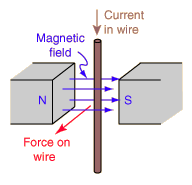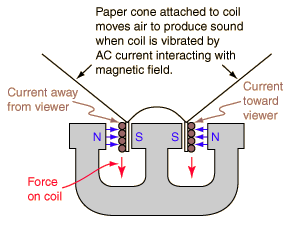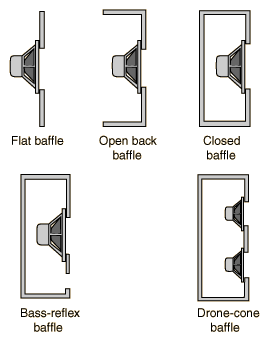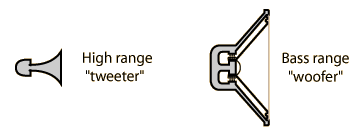Dynamic Loudspeaker Principle

A current-carrying wire in a magnetic field experiences a magnetic force perpendicular to the wire. |
 |
| Loudspeaker basics |
Sound reproduction concepts
Loudspeaker concepts
| HyperPhysics***** Sound | R Nave |
Dynamic Loudspeaker Principle
|
Index Sound reproduction concepts Loudspeaker concepts | |||
|
Go Back |
Loudspeaker Basics
|
Index Sound reproduction concepts Loudspeaker concepts | ||
|
Go Back |
|
Index Sound reproduction concepts Loudspeaker concepts | ||
|
Go Back |
Types of EnclosuresThe production of a good high-fidelity loudspeaker requires that the speakers be enclosed because of a number of basic properties of loudspeakers. Just putting a single dynamic loudspeaker in a closed box will improve its sound quality dramatically. Modern loudspeaker enclosures typically involve multiple loudspeakers with a crossover network to provide a more nearly uniform frequency response across the audio frequency range. Other techniques such as those used in bass reflex enclosures may be used to extend the useful bass range of the loudspeakers.  |
Index Sound reproduction concepts Loudspeaker concepts Reference Cohen | ||
|
Go Back |
Use of Multiple Drivers in LoudspeakersEven with a good enclosure, a single loudspeaker cannot be expected to deliver optimally balanced sound over the full audible sound spectrum. For the production of high frequencies, the driving element should be small and light to be able to respond rapidly to the applied signal. Such high frequency speakers are called "tweeters". On the other hand, a bass speaker should be large to efficiently impedance match to the air. Such speakers, called "woofers", must also be supplied with more power since the signal must drive a larger mass. Another factor is that the ear's response curves discriminate against bass, so that more acoustic power must be supplied in the bass range. It is usually desirable to have a third, mid-range, speaker to achieve a smooth frequency response. The appropriate frequency signals are routed to the speakers by a crossover network.  |
Index Sound reproduction concepts Loudspeaker concepts | ||
|
Go Back |